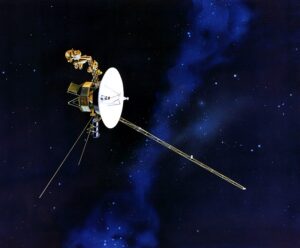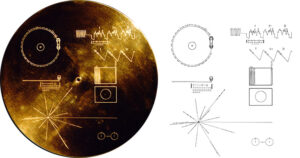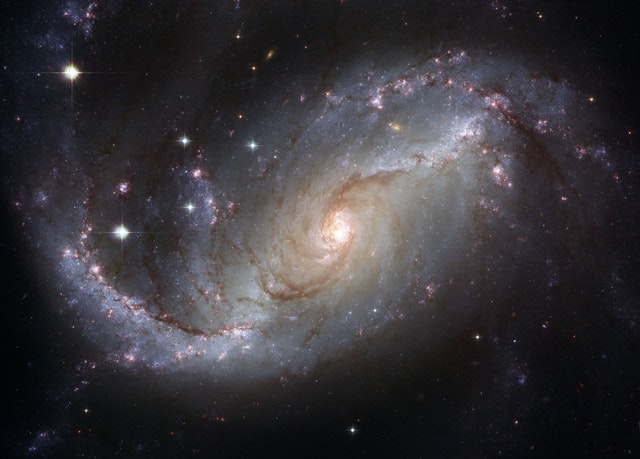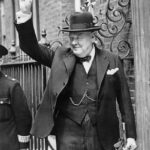In his life Beethoven always aimed ever higher, creating more and more ambitious compositions for eternity. He wished to leave something behind. Today, in deep space, on a spacecraft that traveled further from Earth than any other human made object, there is a phonograph record carrying his music.
What is Voyager 1 and 2?
Voyager 1 (and its twin, Voyager 2) is a space probe that NASA launched in 1977. It has two main missions. The first, to study our Solar System, was completed between its launch in September 5, 1977 and August 25, 2012, when

Voyager 1 left our Solar system and entered interstellar space. It was the first human made object to do so. In this second phase of its mission Voyager 1 keeps on sending data to Earth enabling scientists to make further discoveries especially on the very nature of energy and radiation in space.
Voyager 2 is identical to Voyager 1, but had a different trajectory and different missions to accomplish.
The Golden Record

Preceding spacecrafts Pioneer 10 and 11, both carried a small plaque with their time and place of origins. With Voyager 1 and 2 NASA had a more ambitious plan in mind. A golden record was made, a 12-inch (30 cm) phonograph, that contains selected sounds and images from planet Earth.
The cover has the user manual, engraved. Basically, it shows how to play the record properly and what is the correct speed for the play. As for the visual records, it shows how to decode the pictures and if done accordingly, the first image should be a circle.
For the decoding, aliens will need a fundamental time scale. As a hint, scientists put the drawing of a hydrogen atom in its two states, two circles in the lower right-hand corner. The atom’s transition from one state to the other is the base unit of time.
Finally, the diagram also tells the aliens our Sun’s position in the Universe.
What is on the Golden Record?
The contents of the Golden Record of Voyager 1 and 2 has four categories: images, music, sounds and greetings. The selection was made by a committee led by Carl Sagan of Cornell University.
The 115 images are carefully selected to show basic information about life and science on Earth. Mathematical and chemical definitions, diagram of the Solar system, a DNA structure, male and female diagram are among the scientific messages. The rest of the images are showing situations from everyday life, like how we lick ice cream, how we fish with nets or even a traffic jam.
The sounds are also selected to give an overview on life on Earth. There are sounds of wind, rain, thunder, animal sounds like of a dog, elephant or a whale. Artificial sounds, like a bus, train or airplane, and human related sounds, a kiss or a mother and her child, also part of the record.
Greetings in 55 languages were included. Some of them are ancient languages, some of them are contemporary. The greetings can be a one-word salutation like the Aramaic “Peace!” or longer greetings like the Mandarin Chinese “Hope everyone’s well. We are thinking about you all. Please come here to visit when you have time.”
The rest of the golden record is a 90-minute-long selection of music. Both Eastern and Western classics and a variety of ethnic music are part of the play.
The record has the inscription “To the makers of music – all worlds, all times”.
Which classical compositions were included on the Golden Record?
NASA included on the Golden Record four classical composers: Bach, Beethoven, Mozart and Stravinsky.
J.S. Bach, with his harmony and balance, has the honor to have three compositions on the record:
– the Brandenburg Concerto No. 2 in F., First Movement
– the “Gavotte en rondeaux” from the Partita No. 3, in E major for Violin
– and The Well-Tempered Clavier, Book 2, Prelude and Fugue in C, No.1.
Urban legend has it that a question was raised, which Bach pieces should be included. The answer from an influential committee member was: all of them! Most certainly this person was biased towards Bach, but nothing close to the level this magazine is towards Beethoven!
Our composer, Ludwig van Beethoven is listed with two compositions. First, the symbol of human persistence, the rebellion against fate and struggle against all odds: the Fifth Symphony’s First Movement.
The second composition is his String Quartet No. 13 in B flat, Opus 130, Movement Five – Cavatina (meaning operatic aria). This movement is slow, emotional, and inward. It is about love and vulnerability. On the original manuscript a waterdrop or possibly a teardrop was discovered at a very intense section – maybe Beethoven’s own.
Mozart and the human voice are represented by The Magic Flute, Queen of the Night aria, no. 14. NASA’s version on the disc is sung by Edda Moser.
Finally, Stravinsky’s Rite of Spring, Sacrificial Dance. If Bach was selected for harmony and balance, this composition had to be the opposite pole. Like a classical heavy metal, it portrays primitive pagan rituals in a very avant-garde style.
Popular Beethoven Magazine made the calculation and proudly found that even though Bach has three compositions versus Beethoven’s two, with 13 minutes and 57 seconds Beethoven’s music is the longest section on the record! Take that, JSB…!
Maybe, one day aliens from deep space will read this magazine’s articles with great interest about this outstanding composer, Beethoven, who’s music they first heard on a strange golden record, attached to a spacecraft…
The Future of Voyager 1 and 2
As years and decades passed, one at a time, parts of the system were shot down in-order to save energy. The thermoelectric generators are putting out less and less electricity every year – space is dark and cold. In 1990, for example, all the cameras were shot down, even the software running them was deleted to save memory and of course, energy.
NASA expects them to operate some and at least one science instrument till 2025. After that only engineering data will be transmitted back to Earth. The two Voyagers will leave the communication network’s range around 2036. After that, we will not know about the fate of them.
On the record the first among the messages is an introduction from then UN Secretary General Kurt Waldheim. His message was the following
“As the Secretary General of the United Nations, an organization of 147 member states who represent almost all of the human inhabitants of the planet Earth, I send greetings on behalf of the people of our planet. We step out of our solar system into the universe seeking only peace and friendship – to teach if we are called upon, to be taught if we are fortunate. We know full well that our planet and all its inhabitants are but a small part of this immense universe that surrounds us, and it is with humility and hope that we take this step.”
As the saying goes, there is no second chance to make a good first impression. We had sent Beethoven to do the job, so, consider it done…







